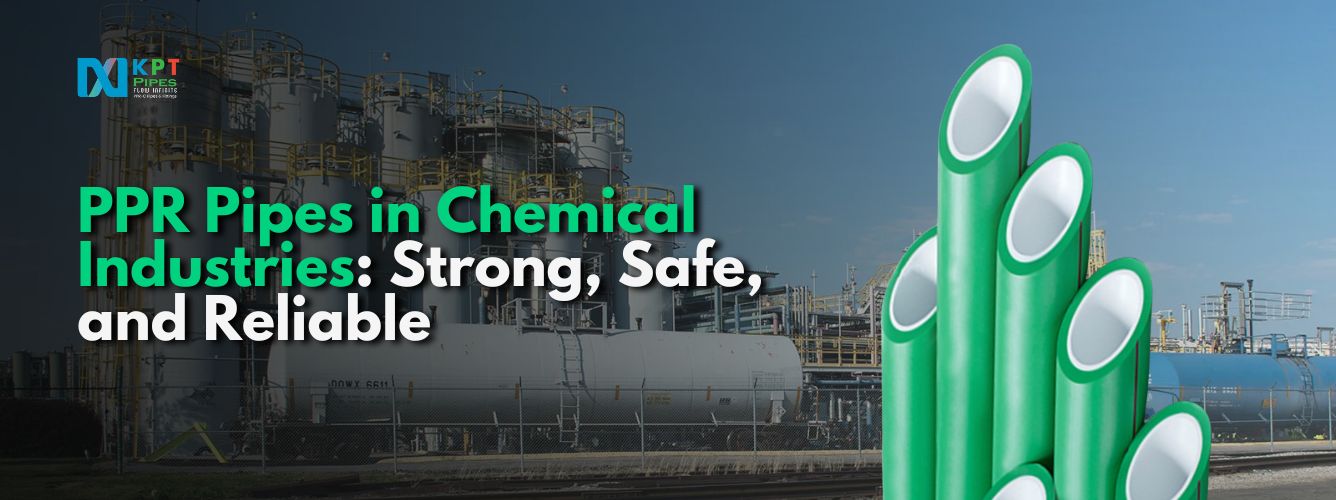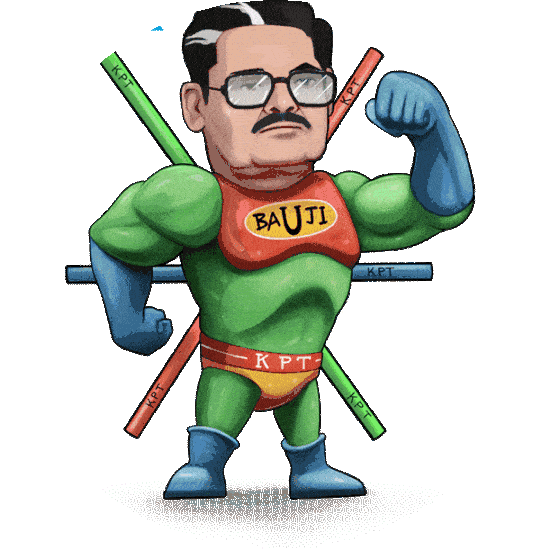
28 Jan PPR Pipes in Chemical Industries: Strong, Safe, and Reliable
In the chemical industry, the integrity of piping systems is critical to ensuring safe and efficient operations. Pipes must withstand harsh chemicals, extreme temperatures, and high pressures while maintaining their structural integrity and safety. Using PPR Pipes in Chemical Industries has emerged as the preferred choice due to their exceptional strength, safety, and reliability. Let us delve into the reasons behind their widespread adoption and explore the benefits they bring to this demanding sector.
Understanding PPR Pipes and Fittings
PPR Pipes and Fittings are made from Polypropylene Random Copolymer (PPR), a type of plastic known for its durability, flexibility, and resistance to chemical corrosion. These pipes are constructed using a random copolymerization process, which enhances their mechanical and thermal properties. PPR pipes are available in various grades and types, including single-layer and multi-layer options, each designed to suit specific industrial applications. Their adaptability and robust nature make them a popular choice in modern piping solutions.
Why PPR Pipes Are Ideal for Chemical Industries
The chemical industry presents unique challenges that require robust and specialized piping systems. The use of PPR Pipe in Chemical Industries helps to meet these challenges with their outstanding properties:
- Chemical Resistance: PPR pipes exhibit excellent resistance to a broad spectrum of chemicals, including acids, alkalis, and solvents. This makes them ideal for transporting aggressive substances without the risk of degradation or contamination. Their chemical resistance ensures safe and reliable operation in even the most corrosive environments.
- High Thermal Resistance: Chemical processes often involve high-temperature environments. PPR pipes can withstand temperatures up to 95°C (203°F), ensuring their functionality in demanding conditions. This property allows them to maintain their structural integrity and performance over extended periods.
- Corrosion-Free Operation: Unlike metal pipes, PPR pipes do not corrode when exposed to chemicals or moisture. This ensures long-term performance and minimizes maintenance costs. Their corrosion resistance enhances the longevity of piping systems in chemical industries.
- Mechanical Strength: PPR pipes are designed to endure high pressures, making them suitable for transporting chemicals over long distances or under challenging operational conditions. Their robust construction ensures reliability in critical industrial applications.
- Safety and Hygiene: PPR pipes are non-toxic and do not release harmful substances into the transported chemicals. This makes them a safe option for industries that prioritize purity and safety. Their hygienic properties are especially valuable in sensitive applications.
- Longevity: With a lifespan exceeding 50 years under normal operating conditions, PPR pipes offer durability that outperforms many traditional materials. This long lifespan reduces the need for frequent replacements, contributing to cost-effectiveness.
Applications of PPR Pipes in Chemical Industries
PPR Pipes and Fittings are used in various chemical industry applications, including:
- Chemical Transport: PPR pipes are employed for transferring a wide range of chemicals, including acids, bases, and solvents. Their resistance to chemical degradation ensures safe and efficient transportation. This makes them indispensable in maintaining operational efficiency.
- Process Piping: In manufacturing plants, PPR pipes facilitate process piping for chemical reactions, blending, and synthesis. Their high mechanical and thermal resistance makes them suitable for such critical operations, ensuring smooth workflows.
- Waste Management Systems: PPR pipes are used in chemical waste management systems to handle corrosive and hazardous waste materials without compromising safety. Their robust nature ensures the safe disposal of waste byproducts.
- Cooling and Heating Systems: Chemical plants often require cooling and heating systems for temperature regulation. PPR pipes are ideal for circulating hot and cold fluids due to their thermal resistance. Their efficiency aids in maintaining controlled environments.
- Compressed Air Systems: PPR pipes are also used in compressed air systems, ensuring efficient and safe transportation of air in industrial environments. Their durability and leak-proof nature contribute to operational safety.
Advantages of Using PPR Pipes in Chemical Industries
- Cost-effective: PPR pipes are lightweight and easy to install, reducing labour and transportation costs. Their long lifespan further contributes to cost savings by minimising replacement needs. These attributes make them an economical choice for large-scale installations.
- Leak-Free Joints: PPR pipes are joined using heat fusion, creating a seamless and leak-proof connection. This ensures safety and efficiency in chemical transport. The leak-free design minimizes the risk of contamination and material loss.
- Energy Efficiency: The smooth internal surface of PPR pipes reduces friction, allowing fluids to flow with minimal resistance. This enhances energy efficiency and lowers operational costs. The decreased energy usage is by sustainability objectives.
- Environmental Benefits: PPR pipes are recyclable and environmentally friendly. Their production generates fewer emissions compared to traditional materials like steel and copper. This eco-friendly nature supports green initiatives in industrial operations.
- Versatility: Available in various sizes and grades, PPR Pipes and Fittings can be customised to meet specific requirements in chemical industries, ensuring adaptability to diverse applications.
Maintenance and Safety Tips for PPR Pipes
To maximize the performance of PPR Pipes in Chemical Industries, consider the following installation and maintenance guidelines:
- Proper Design and Planning: Ensure the piping system is designed to handle the specific chemical, temperature, and pressure conditions of your application. A well-planned system minimizes operational risks and enhances efficiency.
- Use Appropriate Fittings: Select fittings that are compatible with PPR pipes to ensure a secure and leak-free connection. High-quality fittings contribute to the overall reliability of the system.
- Regular Inspections: Conduct periodic inspections to identify and address potential issues, such as mechanical stress or external damage. Taking proactive measures can help avoid expensive repairs and minimize downtime.
- Preventive Maintenance: Implement preventive maintenance practices, such as cleaning and testing, to extend the lifespan of the piping system. Routine care ensures consistent performance and safety.
- Follow Manufacturer Guidelines: Adhere to the manufacturer’s installation, operation, and maintenance recommendations to ensure optimal performance. Compliance with guidelines helps maintain warranty coverage and system reliability.
Future Trends: PPR Pipes in Advanced Chemical Applications
The chemical industry is evolving, and so are the demands on piping systems. PPR Pipes and Fittings are poised to play a pivotal role in advanced applications due to ongoing innovations:
- Enhanced Chemical Resistance: Research is underway to develop PPR materials with enhanced resistance to more aggressive chemicals, expanding their applicability. These advancements aim to meet the growing demands of specialized industries.
- Improved Thermal Properties: Advancements in material science aim to increase the thermal resistance of PPR pipes, enabling their use in extreme temperature conditions. Enhanced thermal properties will broaden their scope of use.
- Smart Piping Systems: Integration of sensors and IoT technology into PPR piping systems is expected to enable real-time monitoring and predictive maintenance, enhancing safety and efficiency. Smart systems will revolutionize industrial piping operations.
- Sustainability Initiatives: The focus on sustainability is driving the development of eco-friendly PPR materials and manufacturing processes, aligning with global environmental goals. These initiatives support industrial efforts to reduce their carbon footprint.
Conclusion
PPR Pipes and Fittings have revolutionized the chemical industry by providing strong, safe, and reliable chemical transport solutions. Their exceptional chemical resistance, thermal stability, and durability make them a preferred choice in demanding environments. As innovations continue to enhance their performance, Using PPR Pipes in Chemical Industries is set to redefine safety and efficiency standards.
For industries seeking robust and cost-effective piping solutions, PPR pipes offer an unmatched combination of performance and longevity. By adopting PPR piping systems, chemical industries can achieve operational excellence while prioritizing safety and sustainability.
FAQs
Q1. What are PPR pipes made of?
Ans: PPR pipes are made from Polypropylene Random Copolymer, a type of plastic known for its durability, flexibility, and resistance to chemical corrosion.
Q2.Can PPR pipes handle high temperatures?
Ans: Yes, PPR pipes can withstand temperatures up to 95°C, making them suitable for high-temperature chemical processes.
Q3.Are PPR pipes safe for transporting hazardous chemicals?
Ans: Absolutely. PPR pipes are non-toxic, corrosion-resistant, and designed to handle aggressive chemicals safely.
Q4.How long do PPR pipes last?
Ans: PPR pipes have a lifespan of over 50 years under normal operating conditions, making them a durable solution.
Q5.What maintenance is required for PPR pipes?
Ans: Regular inspections, cleaning, and adherence to manufacturer guidelines are recommended to ensure optimal performance and longevity.



